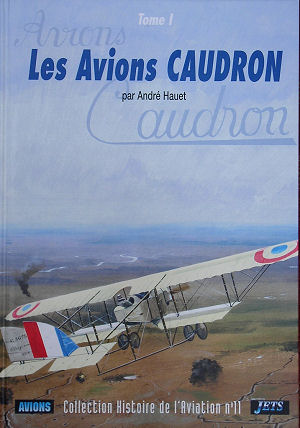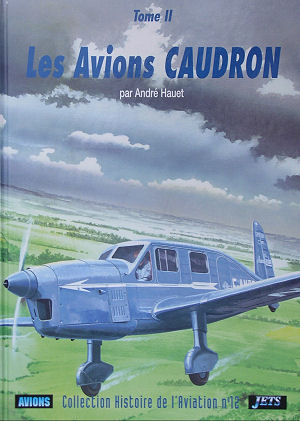 Characteristics:
Characteristics:
|
Title: |
Les avions Caudron part 1 & part 2 |
|
Authors: |
André Hauet |
|
Publisher |
LELA PRESSE |
|
Price |
Approx 63.75 $ USD (53 €uro+ p&p) each |
|
Reviewer: |
|
|
Notes: |
ISBN 9782914017138 (vol1) & ISBN 9782914017008 (2) |
 Characteristics:
Characteristics:
Volume 1 (1908-1932), A-4 format, hard cover, 256 pages, 424 pictures in b/w, drawings . French text.
Volume 2 (1932-1944), A-4 format, hard cover, 288 pages, 423pictures in b/w, 9 in color, drawings, 29 color profiles. French text.
Bloch, Potez, Morane, Breguet, Hanriot, Dewoitine… here are some familiar names from french aircraft manufacturor listing who produced famous military aircraft during the 20th century first quarter. An other one is less known by the public, but got respect from specialists. In 1933, a blue bird won the second place during the Deutsch de la Meurthe race cup at 317 km/h. It’s a Caudron C.362. BUT the story start earlier in 1882-1884 with the birth of the Caudron brothers Gaston and René, in the North of France. Here is their story, their firm, their aircrafts.
The first volume cover 72 different aircrafts from 1908 to 1932. Most of them are biplanes, as on the rest of the world. The most famous are the Caudron G3 /G4 (recon and bomber) during WWII. Exported, they will also take service in foreign air forces or civil companies (in USA too). After the war, the programs turned around the light and medium freight and passenger aircrafts as trainers and light civil tourism planes. For each aircraft, pictures follow the dimensions and characteristics. When technical archives survived, diagrams are displayed, aside drawings. It’s rather funny to come back in the past, with candid shots of trials on the beaches, first aerial fest and meetings, workers in factories...not so far from us indeed, but now we run after the Mach!
 The second volume cover the
other period, from 1932 to the end in 1944. 60 others aircrafts are reviewed.
There, the biplanes are forgotten and the metal appear more and more in the
construction. You’ll discover first the gracefull Caudron Phalène line(high
wing, light transport,) the rageous racers from the coupe Deutsch de la
Meurthe(C.362/366/370/460/450/560/461/712)and the “Rafale” serie (C.
430/530/660/580/680/720/690). As the second War war approached, Caudron also
replied to an Air Ministry program for “light fighters”, and will propose the
C.710/713/714/760/770/780 with the disastrous results we know. In the mean time
a twin engine was launched for air mail duties (C.460), a beautifull bird called
Typhon, with a design close to the De Havilland Comet. To fill the market on
sport and light transport, the Aiglon ( a Mile Master or a Klem cousin) and the
sympatic look work horse “Simoun” (world traveller with 4 passengers and French
Air Force duty) appeared. Heavy versions for transport on an other way were the
Caudron CR 570 (a failure), and the more welknown Caudron Goeland. During
german occupation, the firm was kept under control and built transport aircrafts
for the Luftwaffe, and some civil glider(C.800/810). After the war, the firm
became a member of the SNCAN(Société
nationale de construction aéronautique du Nord), and continue to deliver the
Goeland and C.800 until the end of the activity in 1948.
The second volume cover the
other period, from 1932 to the end in 1944. 60 others aircrafts are reviewed.
There, the biplanes are forgotten and the metal appear more and more in the
construction. You’ll discover first the gracefull Caudron Phalène line(high
wing, light transport,) the rageous racers from the coupe Deutsch de la
Meurthe(C.362/366/370/460/450/560/461/712)and the “Rafale” serie (C.
430/530/660/580/680/720/690). As the second War war approached, Caudron also
replied to an Air Ministry program for “light fighters”, and will propose the
C.710/713/714/760/770/780 with the disastrous results we know. In the mean time
a twin engine was launched for air mail duties (C.460), a beautifull bird called
Typhon, with a design close to the De Havilland Comet. To fill the market on
sport and light transport, the Aiglon ( a Mile Master or a Klem cousin) and the
sympatic look work horse “Simoun” (world traveller with 4 passengers and French
Air Force duty) appeared. Heavy versions for transport on an other way were the
Caudron CR 570 (a failure), and the more welknown Caudron Goeland. During
german occupation, the firm was kept under control and built transport aircrafts
for the Luftwaffe, and some civil glider(C.800/810). After the war, the firm
became a member of the SNCAN(Société
nationale de construction aéronautique du Nord), and continue to deliver the
Goeland and C.800 until the end of the activity in 1948.
This second volume has logically more pictures and drawings than the first one, as the period is closer from us than the beginning of the beginning. To add color to this b/w session, you’ll find at the last stage 9 pictures in color, 29 color profiles of the main aircrafts built, and very interesting reproductions of the engines (Renault) advertising pages.
In summary, these two volumes are the best research ever done on this aircraft manufacturor, not really known outside France by the common guys. Historians and Modelers certainly find that justice is now done. Pioneers must not stay in the dark and be forgotten. Recommended.
January 2006
Available at:http://www.avionsbateaux.com/
If you would like your product reviewed fairly and quickly by a site that has over 300,000 visitors a month, please contact me or see other details in the Note to Contributors.